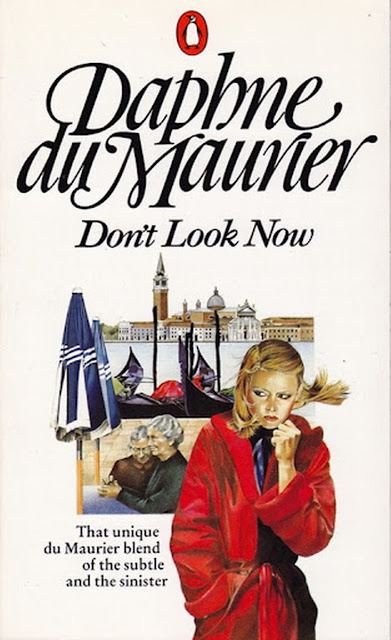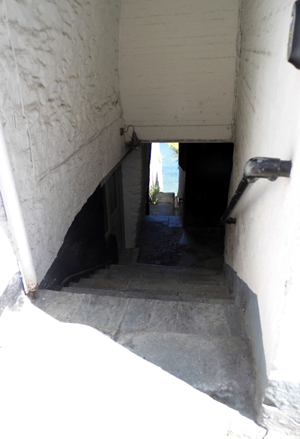We decided to take a short holiday in Cornwall. We live in a resort town at the mid-point of the south coast of England. Mostly, whether for work or pleasure, we head along the Dorset coast, or east (towards London) or north (almost everything else). Cornwall is out on a limb in the south west, and if it weren’t for that county’s stunning natural beauty few people from further east would ever venture there other than to visit family or for work. Fortunately for Cornwall the eastern half of the south coast of England, though it has its beauty spots, just can’t compete. Things begin to pick up west of Southampton, then bloom with the beginnings of the Jurassic Coast (a World Heritage Site) in Dorset. From there on things just get more beautiful as one heads west through Devon and into Cornwall.

Dorset’s most celebrated literary figure is Thomas Hardy. Cornwall has, for our purposes, the much more interesting Daphne du Maurier. So never having read it before, I decided to prepare for our holiday by reading her most celebrated novel, Rebecca. I was familiar with the Hitchcock film, and with the 1997 TV mini-series, but the only du Maurier I had previously read was the novella ‘Don’t Look Now’ and the short story, ‘The Birds’. The former, of course, provided the basis for the great Nic Roeg film starring Julie Christie and Donald Sutherland. The latter, was the source for Hitchcock’s third du Maurier adaptation – Rebecca actually being the second, following Jamaica Inn (1938).
Given that if pushed I would probably cite Don’t Look Now as my favourite horror film, and The Birds as one of my favourite Hitchcock films, one might wonder why I hadn’t previously explored du Maurier’s work further. I think it was because neither of those stories especially impressed me. ‘Don’t Look Now’ in particular disappointed when compared to the film. The film is essentially faithful to the novella, though what felt flat on the page came terrifyingly alive on screen through the great performances of Sutherland and Christie, the superbly atmospheric cinematography by Anthony Richmond and the intensely moving score by Pino Donaggio (who would go on to score many more horror films, including the classic Carrie). Where the film deviates from the novella, either to add incident, such as the fantastically suspenseful sequence in which Sutherland almost falls to his death in a church he is restoring, or in changing details such as making the couple’s daughter, Christine, die from drowning rather than meningitis, it is an improvement. Where more terrifying to go if your daughter has just drowned than to a city built on water?

As for ‘The Birds’, the key set-pieces of the night siege on the house and the visit to the farm are present, but otherwise when I first read it the story felt to me as little more than a sketch from which the Hitchcock film was extrapolated.
But just for a moment if you don’t think ‘Don’t Look Now’ and ‘The Birds’ are sufficient to justify featuring Daphne Du Maurier on Amazing Stories – many more of her stories have fantastical, or subtly supernatural elements, Castle Dor retells the Arthurian legend of Tristan and Iseult in a modern setting and The House on the Strand is a time travel novel. Her reputation may be mainstream, but her heart leant towards the dark side of genre.
So I read Rebecca and was delighted to discover a powerful, gripping thriller – much darker than the Hitchcock film – and evidencing a fine talent for character and beautifully observed descriptions of the natural world. Yes, there are a few overly wordy conversations about very little (the sort of social chatter du Maurier herself loathed), and if Rebecca is a little slower in developing than it would be today, then it reflects the time in which it was written.
I actually finished reading the novel while we were staying in Looe (where Mark Twain’s family lived before moving considerably further west) which happens to be the next town east of Fowey (pronounced Foy) where du Maurier spent much of her life. Menabilly, the house Rebecca’s Manderley was based on, is just two miles over a headland from Fowey. Daphne du Maurier lived there from 1943 – 69, leasing the house with her new found wealth from the success of Rebecca – book, play and Best Picture Oscar-winning film.

Unfortunately we were not able to visit. The house is private property and not open to the public. However, the beaches featured in Rebecca are along a public coastal footpath and the remains of the ship which inspired the wreck in the novel can still be seen. The beach house which features so significantly in the book is available for holiday rental.
Indeed, armed with a copy of du Maurier’s Enchanted Cornwall from a local secondhand book shop , we were able to get a real feel for the author’s world. It turns out ‘The Birds’ was originally inspired by du Maurier watching seagulls following a tractor at Menabilly Barton Farm and wondering what would happen if the birds suddenly joined forces and attacked. The story is set in and around a fictionalised version of that farm, not in America, as Hitchcock had it.
All around Looe harbour there are signs asking visitors not to feed the seagulls, by order of the harbour commissioners. These notices feature a comical illustration but make the point that the gulls are viscous. We asked our landlady about this and she confirmed that the gulls would dive and swipe food from your hands. She told us she had once received a nasty gash on her index finger from a local Cornish seagull.
 During our holiday we had dinner at Jamaica Inn, now world famous as a result of du Maurier’s book and Hitchcock’s film. Due to the fame of the novel and movie the Inn is much expanded from the day in 1936 when du Maurier and a friend found their way to it while lost on Bodmin Moor and heard tales of its smuggling history. Today Jamaica Inn is a modern pub, restaurant and hotel which has its own du Maurier museum, complete with the author’s typewriter. It is no doubt a world away from how it was in 1936 – it has free wifi now – but without the book and film would it still be there at all?
During our holiday we had dinner at Jamaica Inn, now world famous as a result of du Maurier’s book and Hitchcock’s film. Due to the fame of the novel and movie the Inn is much expanded from the day in 1936 when du Maurier and a friend found their way to it while lost on Bodmin Moor and heard tales of its smuggling history. Today Jamaica Inn is a modern pub, restaurant and hotel which has its own du Maurier museum, complete with the author’s typewriter. It is no doubt a world away from how it was in 1936 – it has free wifi now – but without the book and film would it still be there at all?
On our last day in Cornwall we finally made it into Fowey. I visited the Du Maurier Literary Centre and treated myself to a first edition of Echoes From The Macabre: Selected Stories in Bookends of Fowey, just across the street. This anthology contains both ‘Don’t Look Now’ and ‘The Birds’, as well as seven other stories which, for not having being made into great films, are far less famous.

Fowey is a beautiful harbour town built on an estuary. There is evidence that people were trading from there with the Mediterranean 2200 years ago. One thing struck me about ‘Don’t Look Now’ while visiting Fowey – In Enchanted Cornwall du Maurier writes:
‘The story was triggered in my mind by a visit to Venice. There are rather a lot of frightening little alleys, bridges and streets near the canals before you come to Saint Marco. Walking there one night I saw what looked like a little child, running beside a canal and I thought, this is sinister. The story is very spooky, but then Venice is spooky if you go out at night and walk around the back streets.’

But du Maurier actually lived most of her life in and around a little town which is Venice in miniature. Fowey itself consists of narrow little streets, narrower flights of stone steps running up the hillside and down to the water. They twist and turn, and like the streets of Venice, must echo strangely when the fog rolls in and night falls.
And then across the water are two other small towns, Polruan and Bodinnick, both connected to Fowey by ferry – again, Venice in miniature to the imaginative mind. This was du Maurier’s world. Perhaps she didn’t really have to look as far as Venice, for when Du Maurier first moved to Cornwall as a young woman her family bought the house now known as Ferryside, just across the water from Fowey in Bodinnick. Or perhaps she was too close and it took a visit to Venice to see what was already there every day.
*

We went for a meal in a pub on the waterfront. While we were sitting at our table waiting for our food to arrive I opened my new book and read the opening line of the first story: “Don’t look now,” John said to his wife, “but there are a couple of old girls two tables away who are trying to hypnotise me.”
By the time my wife did look they had gone.
*
Come back next week when I will be reviewing Daphne du Maurier’s Echoes From The Macabre… meanwhile there are more photos from our visit to Cornwall on my Last Word blog.











1 Comment